This cold smoked salmon recipe is my dream come true. Our family loves cold smoked salmon, and I've meant to start making it ourselves for many years. I finally did it! For those of you who have been asking me for a good cold smoked salmon recipe - this is it! It's excellent! You won't be disappointed. I am super excited about it as it makes the finest, the tastiest smoked salmon I've ever tasted, and no other comes even close to it.
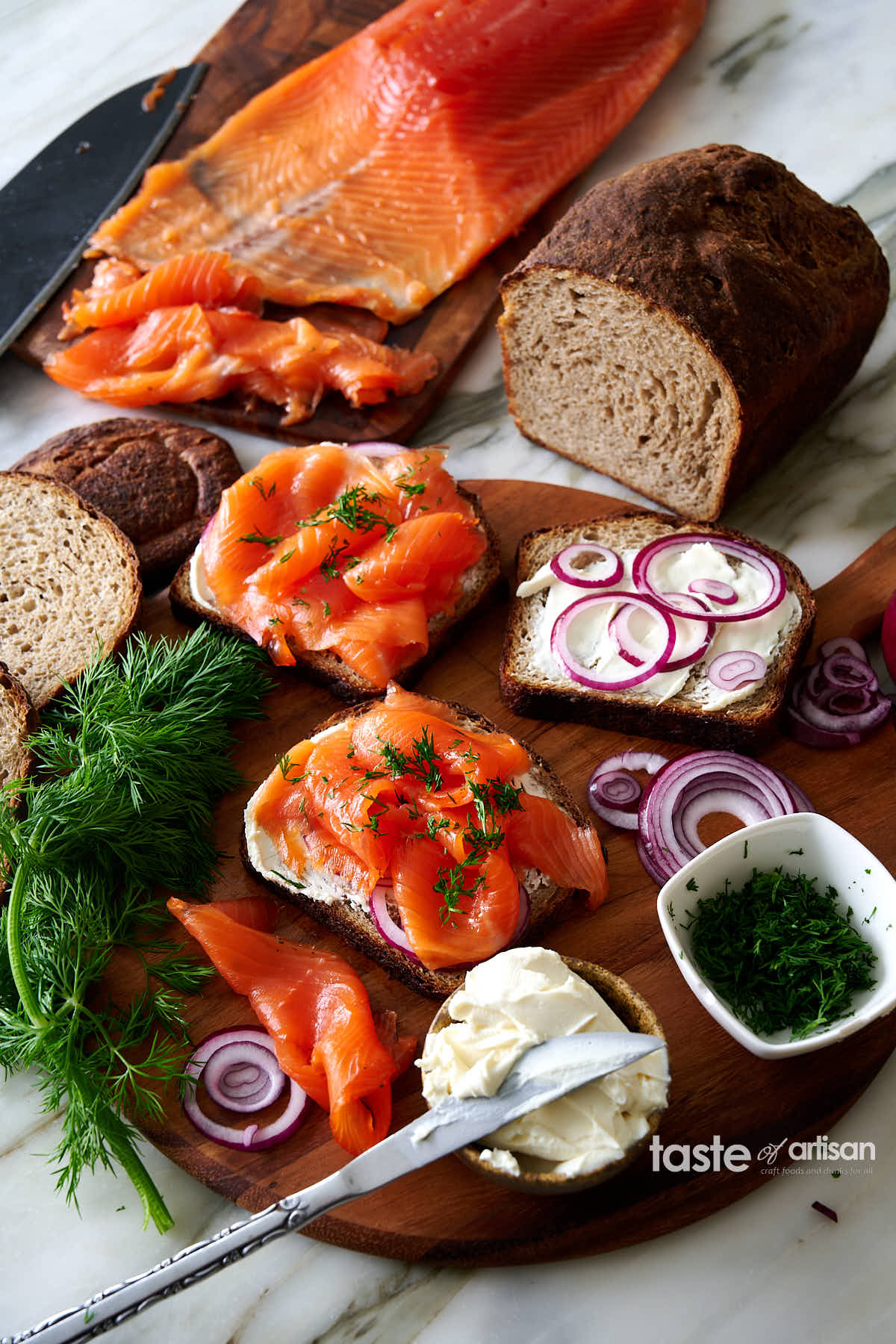
The biggest challenge making cold smoked salmon
My biggest hurdle when attempting cold smoked salmon, or any cold smoked fish, has always been food safety. When you look online and in the literature, you will find dozens of very different recipes. Many are old-fashioned ones that ignore modern safety guidelines. So, which recipe gives excellent results and is safe to use? This one sure was a head-scratcher for me.
I turned to Stanley Marianski, the guru of all smoked and cured, my favorite meat and sausage recipe author. To my vast disappointment, cold smoked salmon recipes in his books turned out to be riddled with discrepancies. One of his books, Home Production of Quality Meats and Sausages, a favorite of mine, recommends brining salmon for cold smoking anywhere from half an hour to two hours, depending on the salmon fillet thickness. In the same book, he also advises brining salmon for 6-8 hours.
Yet, in his Curing And Smoking Fish book, Marianski advises brining salmon in an 80° (degree of salinity) brine for anywhere from 9 to 24 hours, depending on the fillet thickness. The brine is extremely salty; wouldn't it make the fish too salty? I am not a fan of salty food. In the same book, he also advises brining salmon for cold smoking in an 80° brine from half an hour to 2 hours, depending on thickness. Hm... I am lost.
Marianski's dry-salting method is just as confusing. He advises salting fish for 9-24 hours and then keeping it in a 30° (degree of salinity) brine for 1/2 an hour to even out the salt distribution. In the actual recipe, he advises placing fish in an 80° (degree of salinity) brine, but the time is not specified. I was baffled.
Final recipe
After reviewing all the literature I could get my hands on, FDA recommendations on pathogens in cold smoked fish here and here, and testing a number of different recipes, I settled on Marianski's wet-brine recipe that calls for brining salmon fillets in an 80° brine for 9 to 24 hours, depending on thickness. This seems to be the safest method, and the saltiness was perfect to my taste, not saltier than store-bought cold smoked salmon. I believe this is because the fish is soaked for one to two hours in water to remove excess salt buildup closer to the surface.
A few words about cold smoked fish food safety
Cold smoked fish presents a number of potential health risks due to various pathogens and parasites, as described in FDA publications here and here. To me, this doesn't mean that I should not be making one of the most delicious foods ever invented by humankind. It only means that one should carefully follow food safety guidelines when making it.
Before smoking, salmon must be salt-cured sufficiently long to prevent spoilage and pathogenic bacteria growth.
This recipe also uses Cure #1, a specialty-formulated mixture of Salt and Sodium Nitrite, to prevent botulism poisoning, as recommended by Stanley Marianski. Cure #1 also prevents growth spoilage and pathogenic bacteria when fish is in the danger zone - 40F - 140F. It is worth noting that, according to Marianki, up to 90% of botulinum spores are eliminated by removing the fish gills and guts and thoroughly washing the fish gut cavity with tap water.
Finally, it's essential to realize that fish may be infected with parasites. Wild fish are known to be infected with a large variety of parasites. Therefore, raw fish should be frozen to an internal temperature of -4F (-20C) for at least 7 days to kill parasites. It's important to know that many home freezers do not reach this temperature. According to Marianski, freezing may be done before or after smoking. The good news is that nowadays, in many areas, for this exact reason, all commercially sold fish must be flash-frozen before selling.
Selecting salmon for cold smoking
Fish for cold smoking must be of very good quality, plump, firm, and of a pleasant smell. While fresh fish is best for cold smoking, frozen fish is acceptable, too. Flash-frozen fish, done in commercial freezes, have minimal adverse effects on fish texture.
The second most important part is fat content. Fats carry the flavor and provide a pleasant mouthfeel. Fat absorbs smoke particles, making fish smokier and more flavorful. This is the reason why fatty fish taste better when smoked.
Different species of salmon have different fat content. It may be tempting to buy leaner salmon for cold smoking because it's cheaper, but it will come at the price of the final taste. You can't go wrong with King (Chinook) salmon; this is my top choice for cold smoking. King salmon is the fattiest salmon and is very flavorful. It's insanely delicious cold smoked.
The second most fatty salmon is Atlantic salmon. It's a good choice for smoking, but it has less flavor.
Other choices would be Coho and Sockey salmon, which are less fatty, especially Sockeye, and as a result, will have a drier texture and less flavor in the final product.
Preparing the fish
If you start with salmon fillets, you are in luck; not much prep work is required.
If you start with a whole fish, rinse it well, especially the gut cavity. I assume the fish has been gutted; if not, you must do that first. Remove the head, then fillet the fish by running a long, sharp knife as close to the backbone as possible. Next, using pin bone tweezers, trim the fillets and remove the pin bones. That's all there is to it.
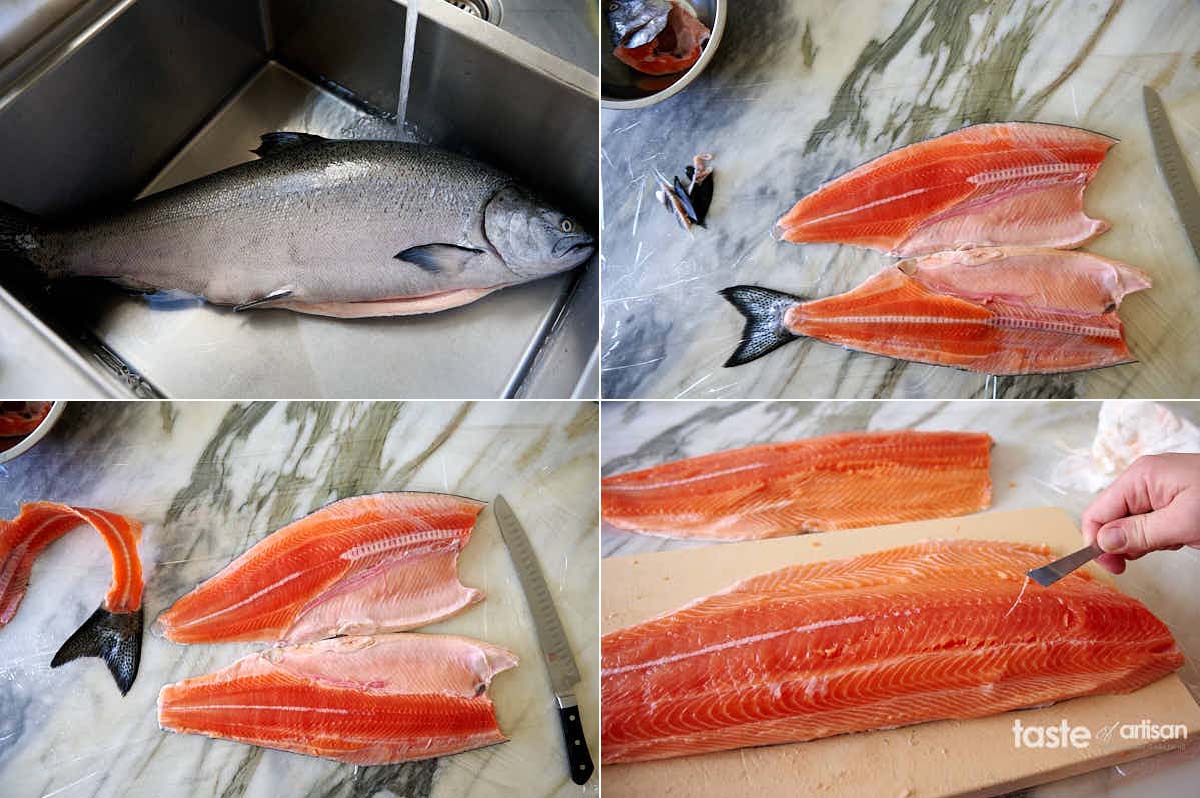
In case you are interested, the yield was precisely 70%. The 3,108-gram whole salmon yielded two fillets weighing a total of 2,163 grams.

Brining
Prior to smoking, salmon is either dry-salted or brined. It's harder to get consistent results with dry salting, while brine penetrates the fish very evenly in thicker and thinner parts. Also, brined fish acquires a glossy shine on the surface and looks much more appetizing. Having tested both methods, I think brining produces more consistent, predictable, and reliable results. This is my preferred method.
On the other hand, salt-cured salmon will lose some water, while brined salmon will not. As a result, salt-cured salmon will need less smoking/drying compared to the brined one to get the same weight loss.
Brine recipe
In this recipe, I am using a slightly enhanced Marianski's basic brine:
1 gallon water
2.25 lbs kosher salt
1 lb brown sugar
2 Tbsp Cure #1
1/3 cup lemon juice
1 Tbsp each garlic, onion, allspice, white pepper, and coriander powder
One gallon of brine is enough for 4-5 lbs of fish.
This brine has the proper salt level (80° strength as measured by a salinometer) for curing salmon intended for cold smoking for the recommended brining time. Please do not change the salt amount in this brine or the prescribed brining time.
To get the most flavor out of this brine, I start with whole allspice, coriander, and white pepper berries, lightly toast them, then grind them in a spice grinder.
Making brine
Make sure that the brine is at 38F before adding salmon. This can be done in two ways. You either start with cold (38F) water or make the brine, then chill it to 38F. Place the brine ingredients in a large bowl and whisk until the salt and the sugar are dissolved.
Brining time
Brining time for making cold smoked salmon depends on the fillet thickness. Assuming we are using an 80° brine, brining times will be as follows:
3/4" thick fillets - 9 hours
1" thick fillets - 12 hours
1 1/2" thick fillets - 18 hours
2" thick fillets - 24 hours
Rinsing salmon after brining
After brining, remove salmon from the brine and rinse under running water. Next, place the fillets in cold water for 60 minutes (3/4" - 1" thick fillets) or 120 minutes (1 1/2" - 2" thick fillets), changing water 1-2 times.
Drying
After brining and rinsing, salmon needs to spend 12 hours in the fridge. This will allow the fish to dry and form a pellicle on the surface. During the drying time, the salt will equalize inside the fillets. Place the fillets skin side down on a baking tray fitted with a cooling rack and refrigerate, uncovered, for 12 hours. You can go longer, up to 24 hours, if necessary.
Smoking
Temperature
Smoking must be done at below 80F (26C). Temperatures above this threshold will cook fish. According to Marianski, all Polish, Russian, or Lithuanian technology books recommend smoking fish at below 72F (22C). Some books occasionally recommend 77F (25C), and old German recipes call for smoking at 64F (18C). Marianski recommends smoking salmon at no higher than 70F (22C) for 12-16 hours, depending on size.
Hanging vs. laying flat
You can smoke salmon either by hanging the fillets or by placing them on stainless steel wire mesh. The latter is my preferred method as it avoids stretching and deforming.
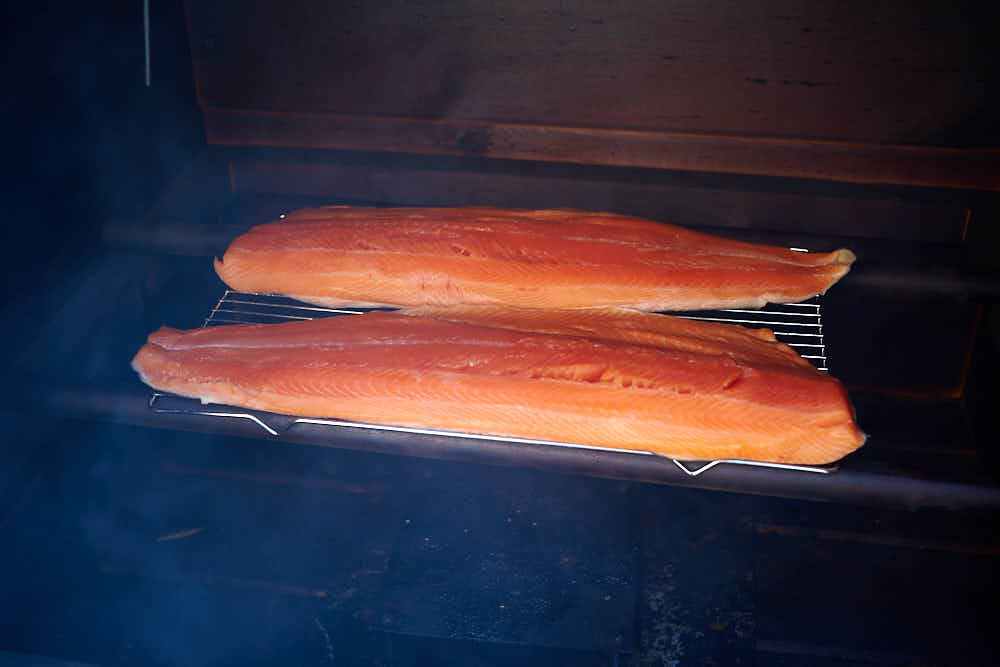
Smoke quality
Try to smoke with clean 'thin and blue' smoke. Otherwise, the fish will acquire a harsh 'chemical' flavor.
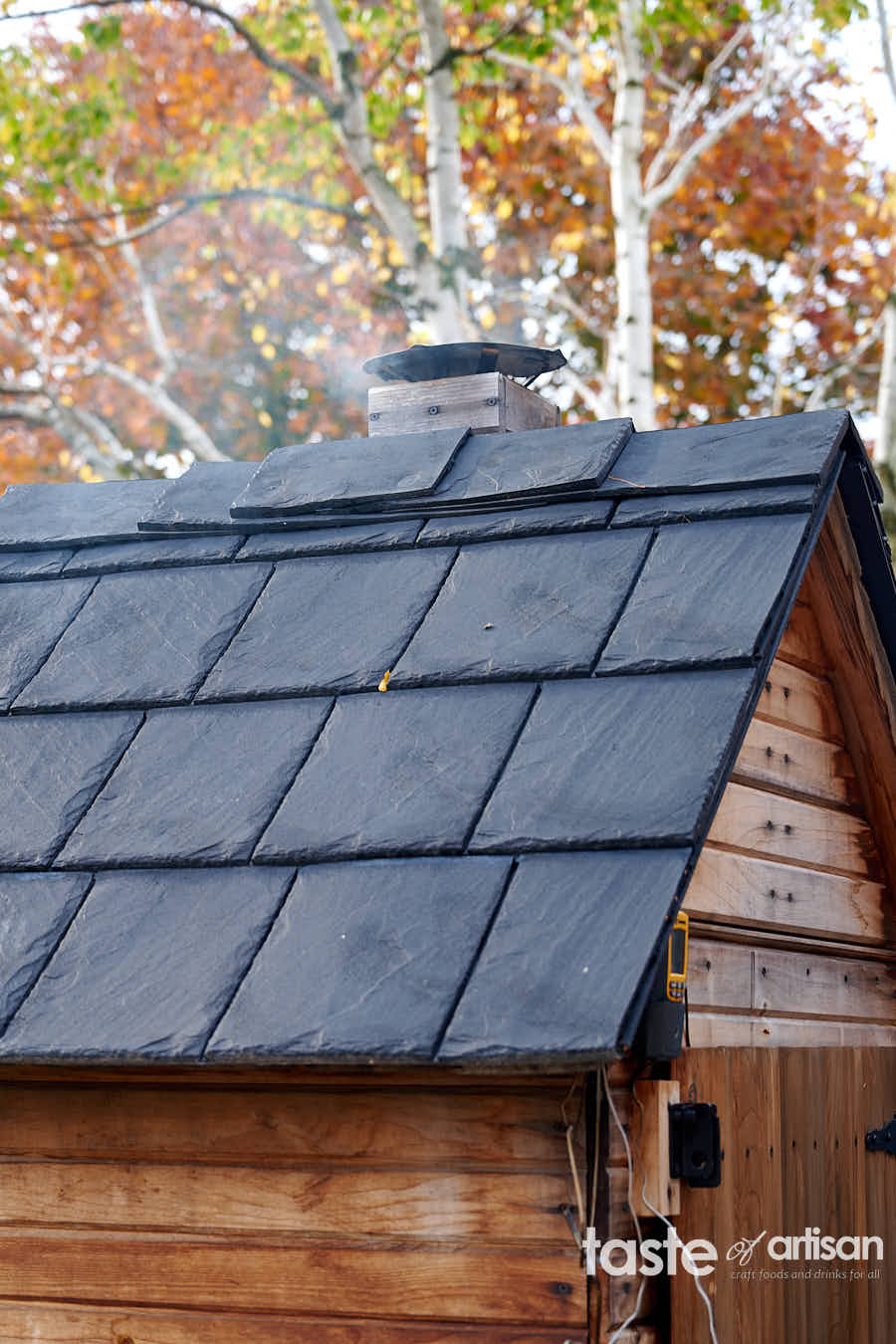
Wood for smoking
The choice of wood is personal. Different regions prefer using different types of wood for smoking fish. The choice seems to be dependent on local availability. Alder, beech, oak, and poplar are good choices, among others. Hickory and fruit tree wood are also good choices and give fish a nice color.
Cold smoking equipment
I have no problem maintaining 70F in my DIY smokehouse as long as ambient temps are below about 62F. Higher ambient temps will make it more challenging, if not impossible, to maintain 70F in the smoker, so pick the smoking day wisely.
Having used many smokers over the past 15 years, if I didn't have my smokehouse, I'd opt for an electric Masterbuilt smoker, which I am very familiar with and like, or a similar electric smoker. A gas smoker will be impossible to keep at such a low temperature.
Another option is a DIY box with a cold smoke generator, but make sure that your setup has good airflow as the fish needs not only smoke but also dry while smoking.
If you are interested in building your own smokehouse for cold and hot smoking of fish and meats, check out my DIY smokehouse design. It's very versatile, and I love its performance all year round. Otherwise, check out Stanley Marianski's Curing And Smoking Fish and Meat Smoking And Smokehouse Design books; he provided many details and designs for various smokehouses.
Determining Smoked Salmon Doneness
Practically no recipes talk about objective measures of smoked salmon doneness. When is smoked salmon done?
There are two things you need to pay attention to: color and weight loss.
Color
The light orange color will change to dark orange, almost a mahogany color. The longer you smoke it, the darker it will become.

The kind of wood you use for smoking will also determine the final color. Oak will result in a lighter color, while hickory, cherry, or pecan will give you a darker color.
Weight loss
There are no strict guidelines on smoked salmon weight loss. However, the more moisture salmon loses during smoking, the longer the resulting shelf life will be. Salmon smoked for several days and even weeks will lose 30% to 50% of the original weight.
Dry-cured smoked salmon will lose about 7-9% during dry-curing and another 7-9% during the 12-hour smoking period at 80F (27C), for a total of 14-18%.
In this recipe, salmon is brined, which results in very little weight loss. Most weight loss will occur during drying/resting in the fridge and smoking.
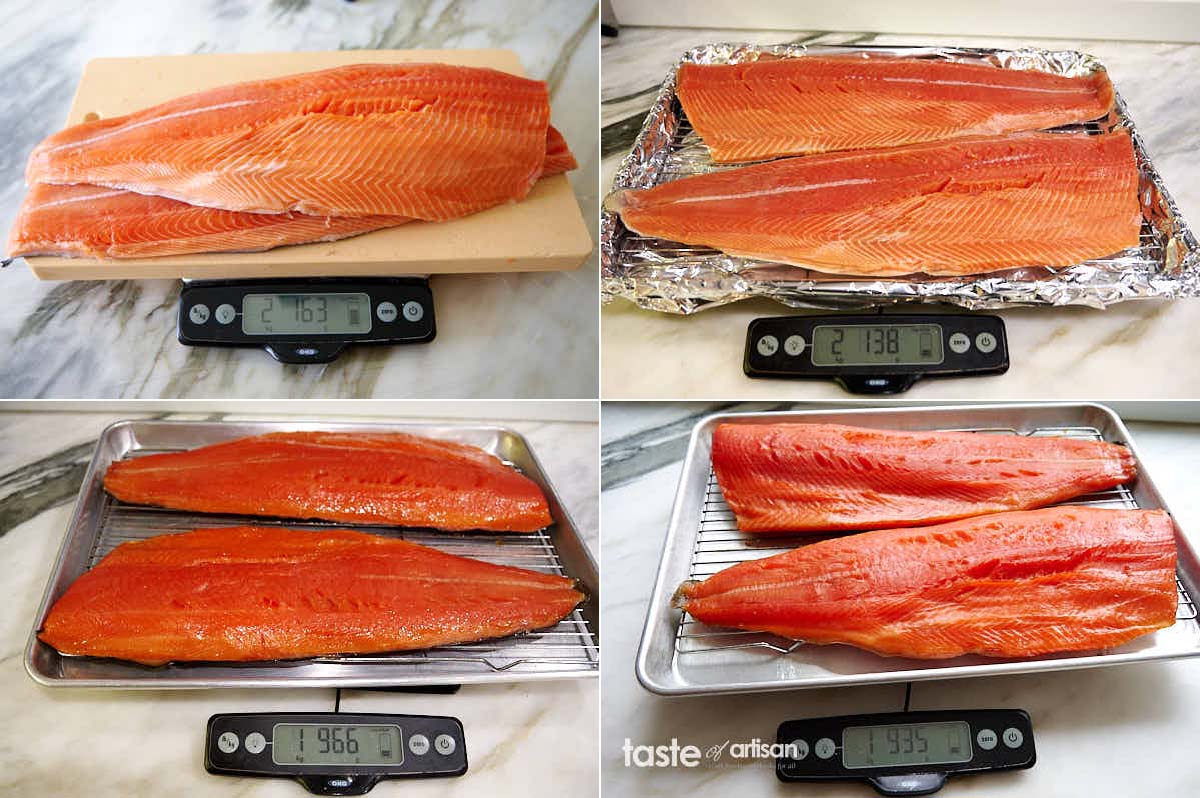
My smoked king salmon went from 2,163 g raw weight to 2,138 g brined and rinsed weight, to 1,966 g after two sessions of smoking (a total of 16 hours), to 1,935 after an overnight rest in the fridge. That's a 10% weight loss. I compared the texture of my smoked salmon to store-bought, and I was quite sure it had nearly identical moisture content. It was perfect for my taste.
Now, a 10% weight loss is not a lot if you want a longer shelf life. If you do, I'd recommend a longer smoking time and/or a more extended rest in the fridge, which will dry out the fish, too.
Personally, I wouldn't want my salmon any drier, so I pack what we aren't going to consume within days and freeze it.
Tasting Notes
As I mentioned above, no smoked salmon I've ever tasted in my life came even close to this one. I love cold smoked salmon, and I've tried it from many different sources/brands. None of them can compare to this one. This salmon has a very rich, pleasant, silky-smooth mouthfeel. Commercial cold smoked salmon has a somewhat tougher, more rubbery texture. One of the more common and more affordable smoked salmon that we used to buy is from Costco. It's a Norwegen cold smoked... wait, it's not even salmon, it's steelhead. It's no wonder the cheaper, leaner salmon-like fish didn't measure up to my smoked chinook.
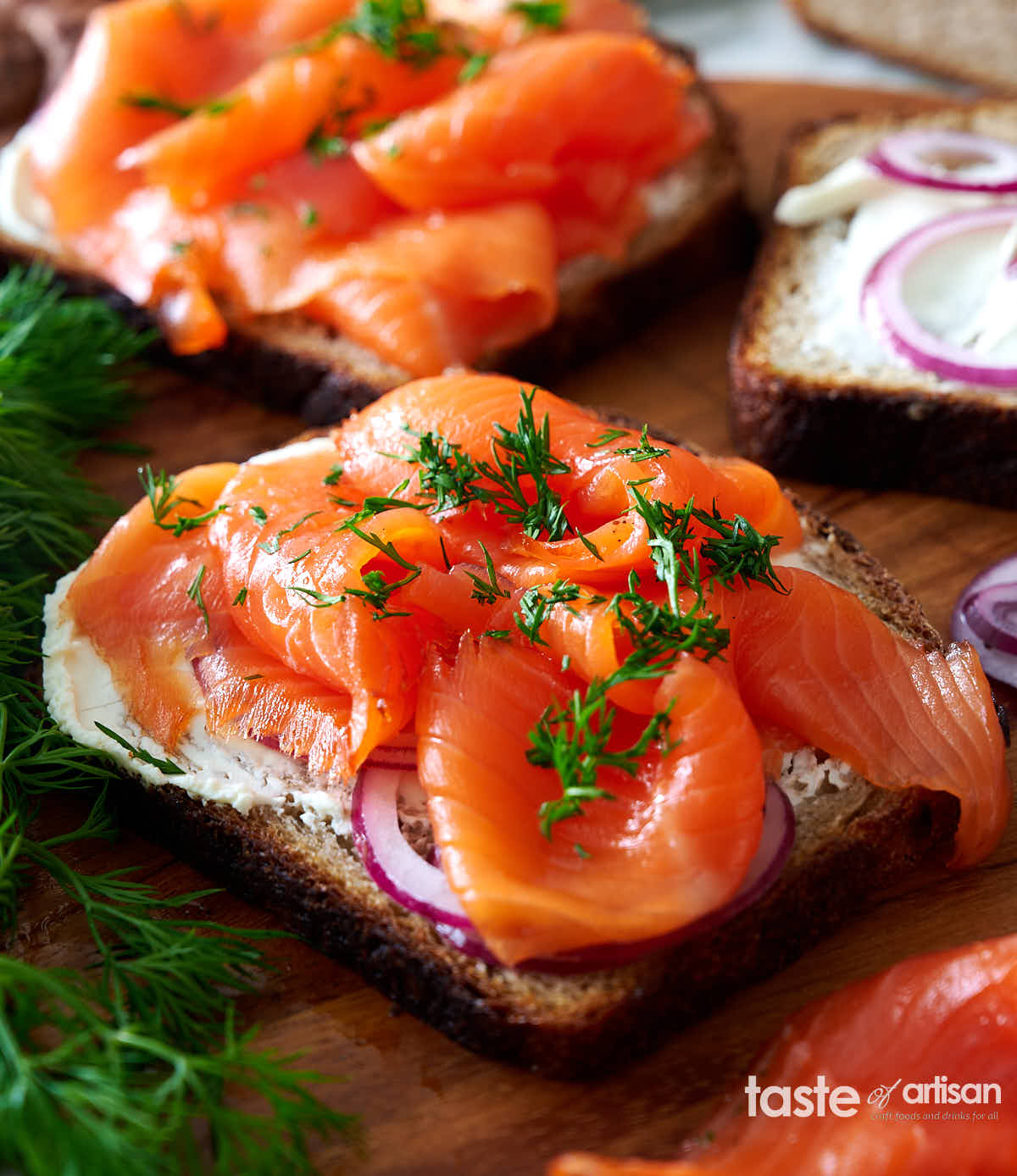
The flavor of most commercial cold smoked salmon is just not there once you compare it to the homemade. Most commercial products don't have a smoky flavor and look pale and unappetizing. The taste is bland in comparison.
Comparison - this is the keyword. I am not going to say that commercial smoked salmon is terrible. Not at all. We've been buying and enjoying it for years. But, in comparison to this one... well, my homemade salmon wins in every aspect by far, to the point where my wife said that she would not buy smoked salmon ever again and told me to make it from then on.
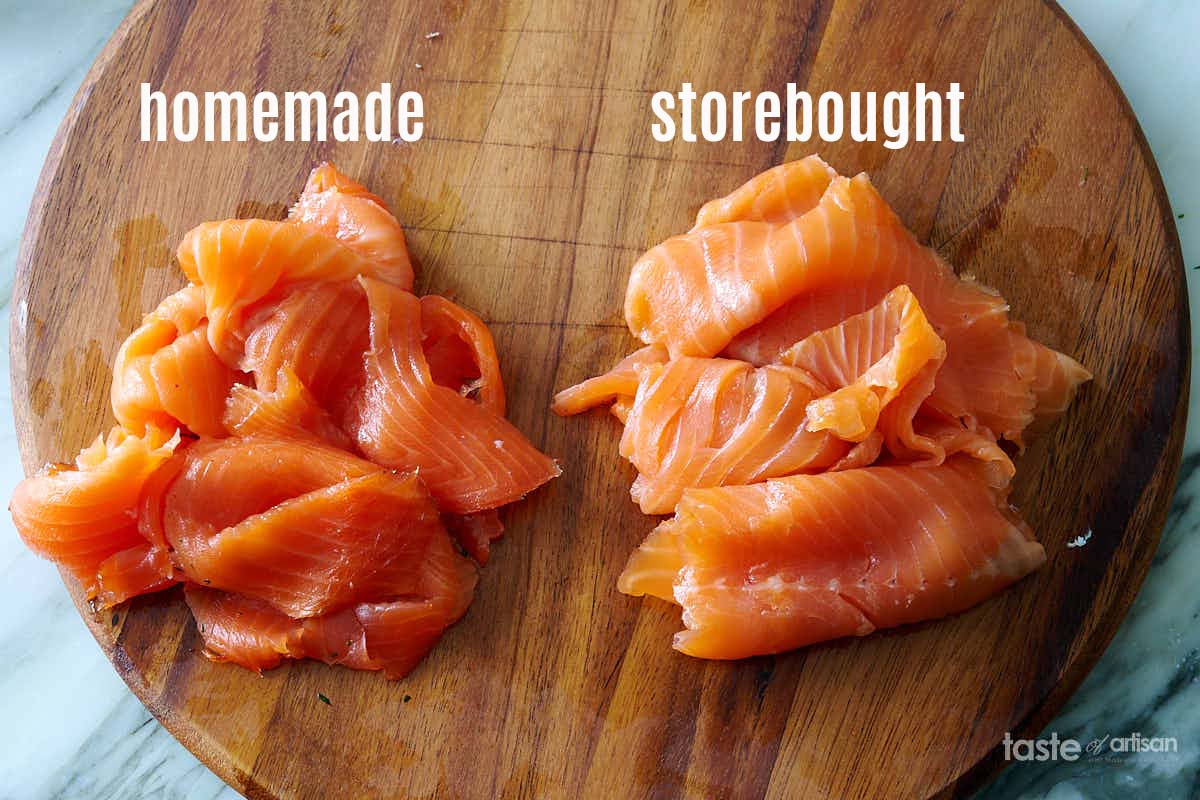
I am good with that, especially that cost-wise, not including my time, of course, my cold smoked king salmon came out considerably cheaper than even commercially smoked steelhead. I've never seen cold smoked king salmon sold anywhere, but if I did, I'd imagine it would be much more expensive than steelhead.
Serving cold smoked salmon
I love smoked salmon sandwiches made with homemade Dark Rye Bread, cream cheese, slices of red onion, and a pinch of chopped fresh dill. Good quality store-bought rye bread will work, too, but if you have some time, you have to make my Dark Rye Bread. It's delicious and goes with cold smoked salmon, lox, or gravlax so well.
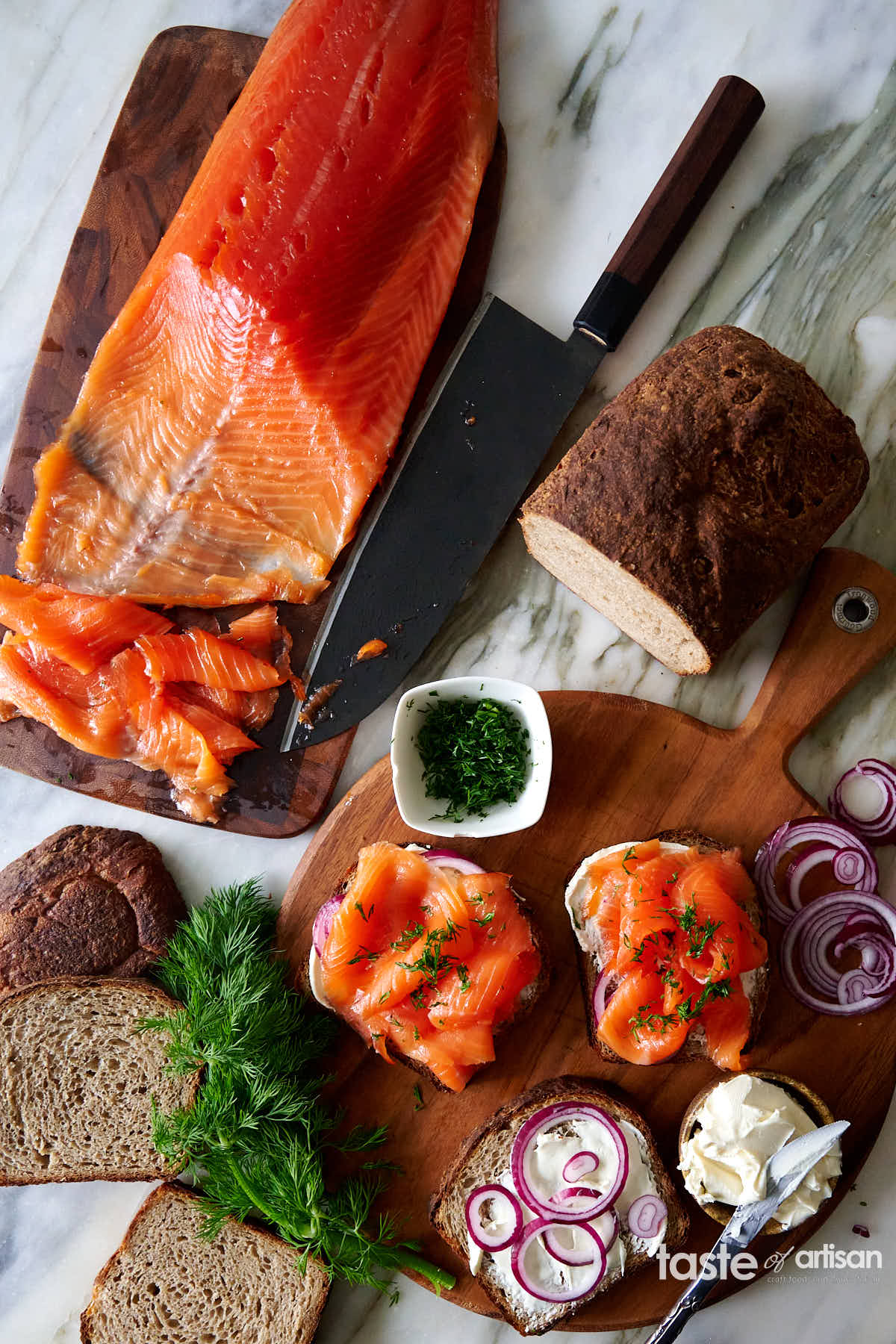
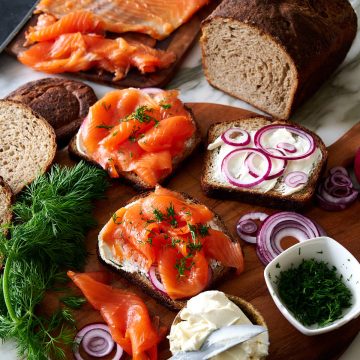
Ingredients
- 5 lbs salmon fillets King/Chinook or Atlantic; about two medium fillets. See Note 1.
For the brine
- 1 gallon water at 38F or lower
- 2.25 lbs kosher salt about 4 cups
- 1 lb brown sugar
- 2 Tbsp Cure #1
- 1/3 cup lemon juice
- 1 Tbsp garlic powder
- 1 Tbsp onion powder
- 1 Tbsp allspice powder See Note 2.
- 1 Tbsp white pepper powder See Note 2.
- 1 Tbsp coriander powder See Note 2.
Instructions
- Add the water and the rest of the brine ingredients to a large bowl and whisk until sugar and salt are fully dissolved. Ensure the brine is at 38F or lower before adding salmon to it.
- Place the fish in a deep pan or something similar. It should be just big enough to fit the fish. Add the brine. Make sure there is enough brine to cover the fish. Slightly weigh the fish down to keep it from floating up. Let the fish brine for 9-24 hours in the fridge, depending on thickness. See Note 3.
- Remove the fish from the brine and rinse under cold running water. Place the fillets in a pan filled with clean cold water and let soak for 60 minutes (.75" - 1" thick fillets) or 120 minutes (1.5" - 2" thick fillets). Change the water once or twice. Drain and pat dry the fish with paper towels.
- Place the fish on a tray fitted with a cooling rack, skin side down, and transfer into a fridge to dry and develop the pellicle for 12 hours. The salt inside the fish will equalize as well during this time.
- Next, move the fish to the smoker and smoke at 70F (22C) for 12-16 hours, depending on size. See note 4.
- After smoking, transfer salmon to a tray, cover, and refrigerate overnight before slicing and enjoying.
- Smoked salmon will stay fresh in the fridge for up to 10 days. Longer storage will require freezing.
Notes
Nutrition


Ed says
What changes if you take the skin off?
Victor @ Taste of Artisan says
Removing skin will expedite brining. It's hard to say for by how much, I but I would say by 40-50%. Which means brining time would be reduced by that much.
Chris says
I love smoked Salmon and was excited to find this recipe! Can't wait to try it. I know there's a lot of choice for wood but I was curious what type you found worked best / what you used above?
Victor @ Taste of Artisan says
I'd say white oak gives me the cleanest smoke. If you know how to control your firepit and get a clean 'thin and blue' regardless of wood, hickory, pecan or cherry are very nice, and give the fish a nice color and a reasonably pronounced flavor... cherry gives the fish a nice dark red color and a sweet smoky flavor. I like it a lot on fish, chicken and pork. There is also the question of availability. I use what's available locally and don't go out of my way to get specific wood. If you glance in my shed right now you will find oak, mesquite (a little bit for some very specific purposes), pecan, hickory and cherry. I use those the most I'd say.
Chris says
Thank you Victor. I tried both Cherry and Oak. Oak was definitely stronger but for some reasons I also struggled with keeping the oak chips going. It was easy for cherry which allowed me to produce a more consistent smoke. With the oak chips I got it kept going out and when I gave more oxygen I got thicker smoke than I wanted. So might just be that rather than the flavor itself; I think a light oak works well (even the heavy oak was not bad, just on a bit unbalanced)
Victor @ Taste of Artisan says
You are right, that's another variable to consider - chips, pellets, sawdust, or chunks. Also, how you generate smoke can give very different results. Nowadays, I use chunks exclusively as those are much cheaper for me to buy and they work best in my BGE smokers. My smoke house is also 'powered' by a BGE mini-max. So, the results that I get will be different from someone using a smoke generator. For me, the most important factor is clean smoke. The second one is flavor. I find that white oak in my BGEs is the easiest to obtain clean 'thin and blue' smoke. Again, that kind of depends on the situation. Oak works best at higher temps for me. At lower temps when I keep the dampers just barely open, all types of wood work fine. When I say that, there are nuances to consider. I can get clean smoke with any wood eventually, but when I need to feed the 'fire pit' and it's 500F-550F hot to give me 140F in the smokehouse, when I add a chunk every 30 minutes or so, it can produce 3-5 minutes of dense, billowy smoke, or it can just go straight to 'thin and blue'. That's the difference I am talking about. When cold smoking, I run the mini-max at a much lower temperature and it behaves differently as far smoke goes. Anyway, there are a lot of nuances to consider and the best approach is to experiment and figure out what works best for your setup. Good luck!
Kristine Ketter says
New to smoking so I am finding your details very helpful. The main thing that does have me nervous is the food safety. I notice you have Pink Curing Salt in your recipe. Is that necessary or just a recommended additive? I’ve not seen it in the other recipes I’ve looked at.
Victor @ Taste of Artisan says
Hi Kristine, you may get different answers from different people, but if you ask me, yes, it's necessary. Stanley Marianski and USDA also say it's necessary. I make cured sausages as well, and I am constantly asked the same question. Sure, you can make salami or smoked salmon without curing salt, but there is a risk of botulism, pathogenic and spoilage bacteria growth. I don't want to take those risks as my family will be eating those meats and fish. Additionally, using pink salt improves color and flavor, and greatly extents shelf life of cured products. So, if you ask me, using pink salt is necessary. Hope this helps.
Mic says
Thanks for sharing this recipe! I've tried it and this won't be my last time. It has had great succes with the entire family! Due to the level of effort required, I will next time double if not triple the number of salmon filets. I did not have an offset smoker but with Canadian winter, i managed to keep the temperature under 80f for about 16hrs. I used a weber smokey mountain and filled my water bowl with snow. To contain and limit heat, i used a small size can to keep charcoal thigh and simply added oak mixed with apple wood every hour or so. As always, i appreciate and enjoy your recipes. They are bang on when it comes to proper level of saltyness! Keep up the great work, I give it a five star!
Victor @ Taste of Artisan says
Thank you for the kind word, Mic. It's very motivating to read that. I also appreciate the detailed feedback. Sounds like you've got the process down. It can be challenge but once you figure it out, it becomes a lot easier. Anyway, glad to hear that you've had success. You are absolutely right about the level of effort/time vs how much you smoke. I felt the exact same way 🙂 So, next time I am going to do a few salmon fillets but I aldo want to add other fish, like flounder, mackerel, cod and haddock, depending on price and availability. Those are also very good for cold smoking. Smoked fish freezes well. I froze half a fillet and we had it for New Year's - it was practically identical to the unfrozen one as far as I could tell. Happy smoking!